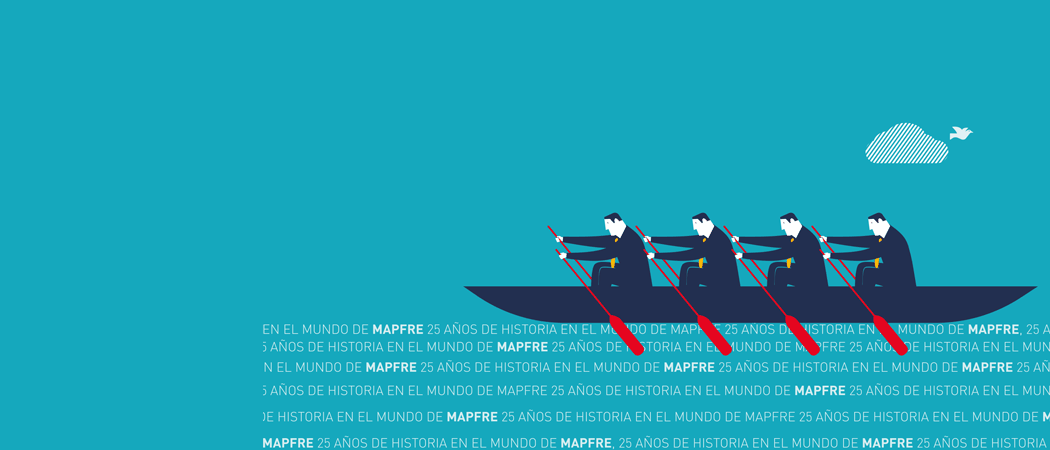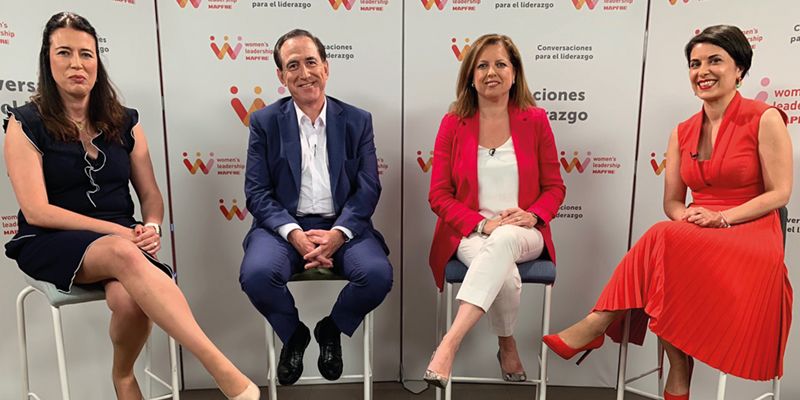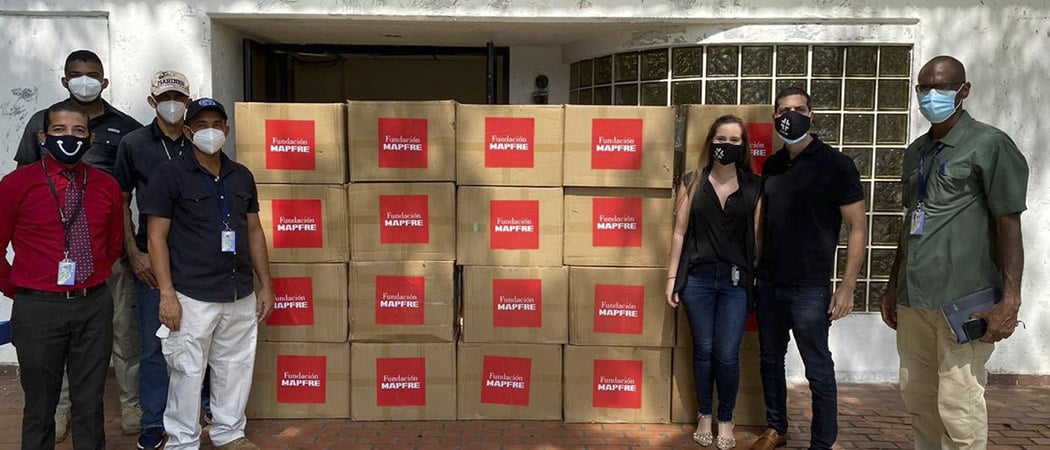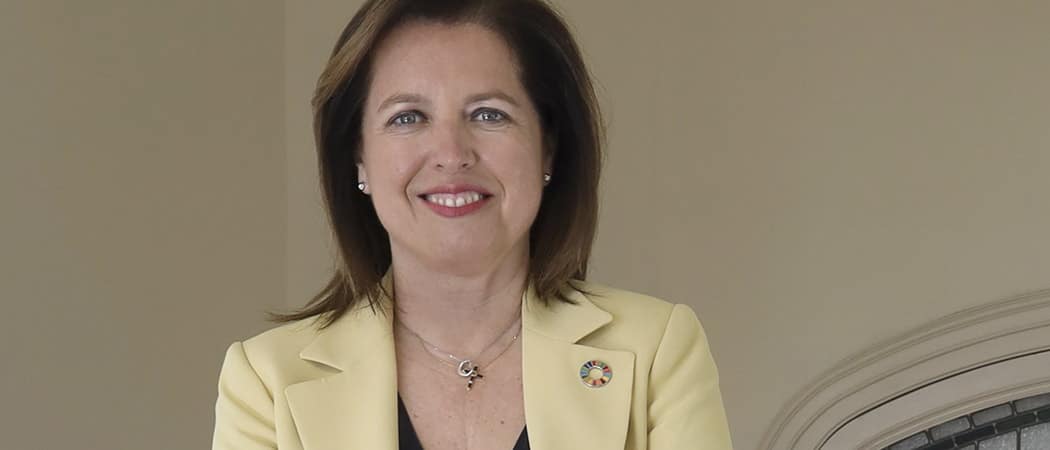It is impossible to summarize in just a few pages what the last 25 years have meant to MAPFRE. Any of us with over 25 years in this company could write this history from the viewpoint of our own experiences. That is why we attempted to highlight the core operations undertaken, companies formed and the commitment to innovation that characterizes this company.
TEXT ANA GUTIÉRREZ @ALVANA72 | ILLUSTRATION THINKSTOCK
This review of MAPFRE’s recent history starts in 1993 with the first issue of our magazine. Spain had just celebrated an emblematic historical milestone. 1992 really boosted the modern, dynamic image of the country and hosting both the Barcelona Olympics and the Universal Exposition in Seville only endorsed this new optimism. MAPFRE locked into this new spirit, adapting to new currents and trends, with the new MAPFRE Tower in Barcelona’s Olympic Port a fine symbol of this boom.
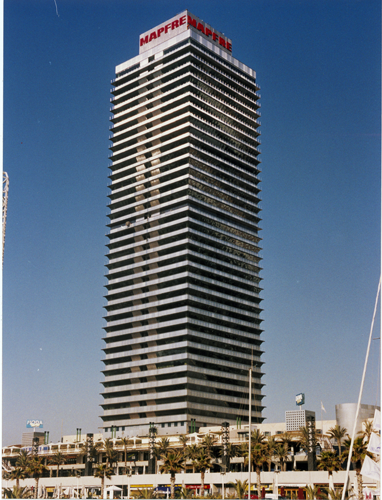
1993
The MAPFRE Tower, with its 40 floors rising 154 meters (505 feet), quickly came to represent the urban redevelopment of the city of Barcelona, becoming a symbol of modernity in Spain
It was then that we started a new magazine section entitled MAPFRE Culture, with the clear aim of progressively informing people about Sistema MAPFRE’s organizational structure, as well as the global philosophy that permeated the whole corporation, present in every one of its units and companies.
Another section of the magazine at that time was dedicated to the Ombudsman for the Insured, a figure created by MAPFRE in 1985 when Ignacio Hernando de Larramendi, head of the group between 1955 and 1990, imported the concept from northern Europe and it was further enhanced by Julio Castelo, chairman up to 2001. MAPFRE pioneered this introduction in Spain, another landmark event for the insurance market. It consisted in the creation of a kind of independent tribunal, which could resolve any issues arising between MAPFRE and its policyholders. Obviously, this needed to be headed by a truly independent person from outside the organization, as acknowledged by Fernando Suárez when he was interviewed in the magazine 20 years later.
One of MAPFRE’s inherent characteristics throughout its history has always been its international expansion philosophy. Thus, in 1995, at the same time as it was expanding its business in Latin America, MAPFRE decided to promote the creation of research institutes such as CESVIMAP in various countries. It was able to rely on the collaboration of local insurers, as was the case of its introduction in Brazil.
Another landmark event that year, coinciding with its 25th anniversary, was when MAPFRE VIDA went public, offering small investors the possibility of also participating in this great business project.
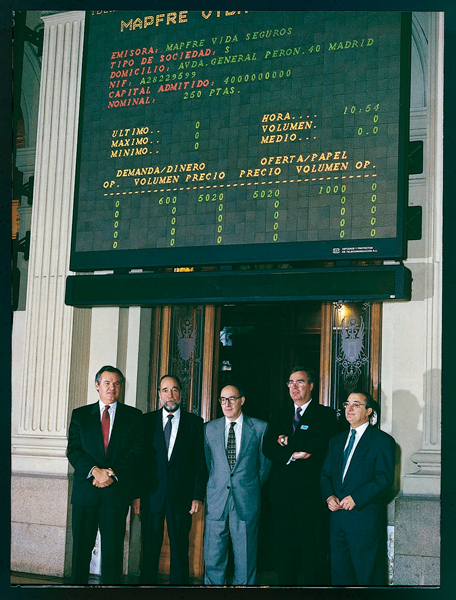
1994
Flotation of MAPFRE VIDA
In early 1996, on the initiative of a group of doctors led by Dr. Pedro Guillén, the first stone was laid of what was to be the CEMTRO Clinic, a trauma center for rehabilitation and orthopedics boasting cutting-edge technology. Subsequently, on May 18, 1998, this clinic would be officially opened by King Juan Carlos.
Continuing in this same innovative vein, in 1997 MAPFRE created MARES, a company created within the automobile unit with the goal of insuring specialty risks, those usually excluded (e.g. young or novice drivers, trucks, buses, etc.) from the insurance activity of MAPFRE MUTUALIDAD and, indeed, the vast majority of insurance companies. Once again MAPFRE was a pioneer, analyzing the behavior of this type of risk so as to be able to calculate the appropriate insurance rates. This innovative spirit surfaced yet again for the creation of the YCAR policy. MAPFRE once more spearheaded innovation in the sector by creating a specific auto insurance policy for youngsters which would help rejuvenate its automobile portfolio.
A major step was taken along the path to becoming a major 21st century business when, in 1998, MAPFRE and Caja Madrid signed a memorandum of understanding to seek business collaboration formulas in the banking and insurance areas. With the start of the new century MAPFRE and Caja Madrid were to consolidate and extend their business alliance, creating the new MAPFRE-Caja Madrid insurance holding in February 2000. That very year would see the holding already bear its first major fruit with the signing of the first significant operation – taking control of the FINISTERRE Group in Spain. This would increase MAPFRE’s market share in the funeral expenses line.
Also that year, continuing to innovate, SEGURMOVIL was launched. This new SEGURMAP service employed a revolutionary system that enabled vehicles to be located in the event of theft, accident or breakdown. Likewise, ARIES (International Business Risks Area) appeared that year. This flagship project from MAPFRE SEGUROS GENERALES was offered by MAPFRE INDUSTRIAL in order to insure the risks faced by clients and multinational companies in Spain, Portugal and Latin America.
As we can see, the 1990s provided tremendous opportunities that MAPFRE proved perfectly capable of exploiting. Another new launch was that of CLUB MAPFRE, a new MAPFRE MUTUALIDAD company consisting of a revolutionary, ambitious project to facilitate and boost the uptake of new customers, while offering a more comprehensive, flexible range of MAPFRE services. This later gave way to what is currently known as Te Cuidamos, which is now being expanded internationally.
A milestone of an internal nature, and most important in the first steps toward corporate transparency, was the creation of Sistema MAPFRE’s Good Governance Code promoted by Julio Castelo. The code set forth the norms needed to regulate the management structure of the corporation, as well as the guiding principles to be followed by the governing bodies of its component companies.
April 2001 saw the handover at the helm of Sistema MAPFRE: Julio Castelo Matrán passed the baton to José Manuel Martínez who, after 30 years pursuing a successful professional career within the company, was to initiate an era marked by MAPFRE taking a new route filled with transformation, creation and expansion.
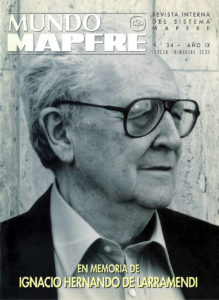
2001
Following his death, the magazine devoted a special issue to the memory of Ignacio Hernando de Larramendi, with a review of both his professional career and his social work
One of these new steps was the launch of MAPFRE.COM, which resulted in the full integration of the company into the 21st century. In the year 2000 MAPFRE set about developing the company’s activities on the Internet, adapting its strategy to the possibilities offered by the emerging online reality of the time, given the evident growth of Internet users around the world – 378 million, four and a half million of whom were in Spain. These were the first steps of the major commitment to digital business which MAPFRE would later undertake. The company was well aware that it had to be in all the channels through which clients could find us.
2002 was a year marked by the slogan “When you think of a car, think of MAPFRE” launched by the company to explore areas such as the purchase, sale and distribution of all makes and models of vehicles, as well as the marketing and provision of other automotive products and services. This was further developed in 2003 with other formulas, such as leasing and financing the purchase of automobiles. MAPFRE Empresas was launched that year and hit the ground running, combining the strengths of MAPFRE INDUSTRIAL and MAPFRE CAUCIÓN Y CRÉDITO. It thus became the Group’s first business unit specialized by type of client.
Yet another landmark event in 2004 saw MAPFRE looking to the future and committed to sustainability: the start-up of CESVIMAP’s Treatment Facilities for End-of-Life Vehicles, the first automated center in Spain for dismantling and recycling vehicles.

2005
Opening of automobile multi-center
2005 marked the launch of the Investment General Management, whose prime objective was to coordinate and make decisions about investment possibilities for MAPFRE all over the world.
The most relevant event in 2006 was the birth of the great 21st century MAPFRE. MAPFRE approved the modification of its business structure to become one of the major international insurance companies. This resulted in Fundación MAPFRE acquiring majority control of the group. All of the Group’s activities were brought under the umbrella of MAPFRE S.A., to be listed on the stock exchange. This was a key step for the company to manifest itself as the major multinational it already was.
Moreover, MAPFRE began to prepare for Solvency II, which was to introduce a better estimation of the actual risks assumed by each insurer.
At the same time as it was gaining relevance as a listed company, MAPFRE continued its expansion process by acquiring 80 percent of the Turkish insurer Genel Sigorta. This marked its entry into direct insurance in Turkey.
That same year MAPFRE began laying the groundwork for moving into China, starting out with operations in the reinsurance and assistance sectors.

2006
Extraordinary Assembly which adopted the new corporate structure
Fruit of the future vision of MAPFRE and its commitment to transformation was the creation of the Technology and Processes General Management in January 2007. It was designed to boost technological renovation, foster a culture of processes, and provide MAPFRE with the tools necessary to align itself with clients’ demands. This ended the lack of IT compatibility existing up to that point.
This year also saw the Group make the largest investment in its history: the acquisition of the U.S. insurance company Commerce for 1,538 million euros.
2008 was the year that MAPFRE celebrated its 75 anniversary and, among other activities, hosted a dinner in the presence of Their Majesties the King and Queen of Spain, where the king proclaimed: “You are celebrating 75 years with legitimate pride, the sum of endeavors and successes leading to the development of a major Spanish company like MAPFRE. A true multinational with sustained growth and prestige in a sector such as insurance, marked by its extreme international competitiveness. Thanks to the efforts of its executives, professionals, experts and office workers, and given its leading position in the sector, MAPFRE is a benchmark company in this modern, dynamic Spain we have built together.”
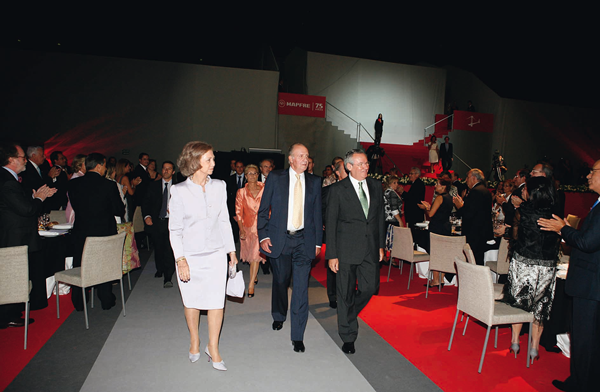
2008
75th Anniversary gala dinner
It was in 2009 that MAPFRE and Banco do Brasil signed a memorandum of understanding to negotiate setting up a strategic alliance whose goal would be the joint development of the insurance business of both groups in the Brazilian market. The terms of this agreement have recently been updated.
MAPFRE was included on the Dow Jones index, the maximum exponent when it comes to recognizing socially responsible policies of enterprises and institutions. This marked international acknowledgement of MAPFRE’s social responsibility policy, making it the only Spanish insurance company on this index.
2010 marked another significant milestone in MAPFRE’s history with the launch of VERTI, a direct insurance company selling automobile and home policies. The new insurer complements MAPFRE’s traditional business model and will compete with online and telephone companies. Spearheading the company’s commitment to digital transformation, it served as the basis for exporting this model to Germany and Italy in 2015, with the acquisition of Direct Line and, later, in the United States in 2017.
Furthering the company’s digital transformation strategy, MAPFRE ASISTENCIA made a giant leap in the direct sales market with the acquisition of the British company InsureandGo, the largest online distributor of travel insurance in the United Kingdom.
Moreover, a memorandum of understanding was signed between MAPFRE and Euler Hermes for the joint development of the credit and surety insurance business in Spain, Portugal and Latin America. The agreement was signed definitively at the end of May 2012 and, in early 2013, SOLUNION was born, a company combining the strengths of these two major insurers.
In 2012 MAPFRE’s eye on the Mediterranean region led to it becoming the majority shareholder of MIDDLESEA GROUP, the leading insurer on Malta.
March 2012 saw the renewal of MAPFRE’s senior management team. José Manuel Martínez retired and Antonio Huertas took over as Group chairman.
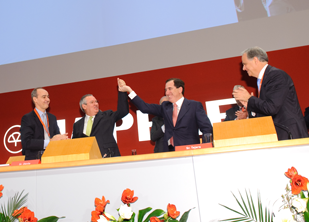
2012
Handover of the chairmanship
Thus began a new phase for MAPFRE, marked by the introduction of a strategy which, more than ever, was to employ the strengths that have always formed part of the company’s success. Throughout these years MAPFRE has stuck to the right path in order to become a global company. It has kept growing, steadily generating value for its shareholders, as well as stable, high quality jobs for its employees. This period focused on prioritizing the various projects, with profitability being the overriding objective. The major challenge was the transformation of the company to adapt to the new digital era. Noteworthy progress was achieved at this time in MAPFRE’s integral management with the introduction of the regionalization process and the consolidation of the Corporate Areas.
This led to the construction of MAPFRE’s Data Processing Center (CPD) in 2014. Located in Madrid, it serves needs at the corporate level, as well as those of all Group companies. The CPD represents the renewal of our company’s technological heart and houses a major part of MAPFRE’s global data and communications.
This was also the year that MAPFRE brought all its training programs together in one place, the Corporate University, which was set up with the aim of further preparing all our employees and promoting a new global learning environment.
An important milestone in MAPFRE’s digital transformation was reached in 2016 with the launch of the Global Intranet. This entails a new way of working, more global and more digital, with tools that aim to facilitate both individual and collective work.
The third quarter of 2016 was marked by the creation of MAPFRE AM, formerly MAPFRE INVERSIÓN DOS, whose objective will be to manage more than 4.8 billion euros for over 300,000 clients, strengthen the global management of MAPFRE’s investments and boost the management of third-party assets within the Group, so as to take advantage of sales opportunities as they arise.
Activities such as the Solidarity Euro and the company’s involvement in volunteering activities have resulted in the number of MAPFRE volunteers doubling over these past two years. More than 6,700 volunteers, employees and relatives have participated in activities that have enabled over 93,000 people at risk of social exclusion in 26 countries to be helped.
If we had to predict the future, or someone had to write the next 25 years of MAPFRE’s history, I would bet that it would all begin by referring to the Digital Challenge. Enhancing our capabilities in the workplace, with the aid of technology, is the key factor in the transformation strategy for any company nowadays. The survival and leadership of enterprises in the medium and long term will largely be determined by the decisions we make these days, these months and these years.

DIGITAL CHALLENGE
ENHANCING OUR CAPABILITIES IN THE WORKPLACE, WITH THE AID OF TECHNOLOGY, IS THE KEY FAC-TOR IN THE DIGITAL TRANSFORMATION STRATEGY FOR ANY COMPANY NOWADAYS
Perhaps we will no longer be here to write about the next 25 years of MAPFRE, but we trust we will be able to read them. A promising future.
This article offers a summary of the articles published in the magazine over these years. We know that many equally important ones as those included here have been left out, but practicalities forced us to make difficult choices in order to keep this article feasible.

